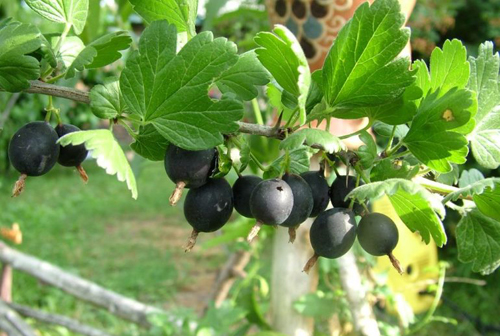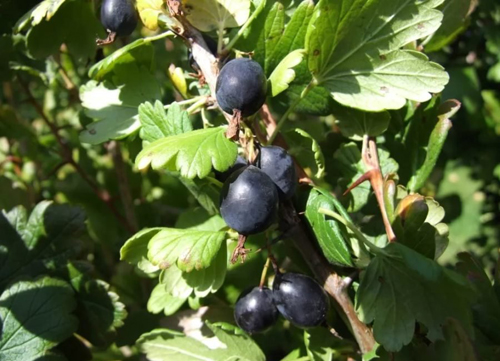Gooseberry variety Black Negus
In a modern garden, you can find not only the novelties of selection. Experienced gardeners, as a rule, grow proven varieties that can be safely called old or retro. These include the Black Negus gooseberry. On the territory of Russia, especially in the Moscow region, the Leningrad and Pskov regions, it is quite common, despite its considerable age. This long-liver was created in the first half of the last century at the All-Russian Research Institute of Horticulture named after V.I. I.V. Michurin. The European large-fruited gooseberry Anibut and the American Dye-tree were chosen as parental forms. The most valuable quality of the long-lived variety has been and remains resistance to powdery mildew. Unfortunately, our hero is not included in the State Register of Breeding Achievements of Russia. Due to the strong thorniness of the branches and small fruiting, the variety did not go into production, but served as an excellent starting material for the creation of new sphero-resistant crops.

Description
The plant is powerful and beautiful, from 1.5 to 2 meters in height, by the age of ten it can grow even higher. Black negus can be used as a hedge along the borders of the site. As a joke, the gardeners nicknamed him gooseberry from an evil neighbor. Spreading bushes, sometimes up to 3 meters wide. Shoots are powerful, strong, arched, grow upward and to the sides, thorns are located in each internode along the entire length. The spines are very sharp, long, single, double or triple, curved downward. The leaves of the variety are large, three- or five-lobed, with a slight short pubescence, delicate to the touch, bright green in color. The surface is dull, slightly wrinkled. The edges of the teeth are rounded. The central blade rises above the lateral ones; the notches between the blades are not too large. The petiole is long, thin, uncolored. The inflorescences consist of one or two medium-sized flowers.
The fruits of the Black Negus are smooth, elongated, pear-shaped, small in size, weighing 2.0 - 2.5 grams. The cup is large, closed. The skin is soft, elastic, not thick, but strong, without pubescence, densely covered with a bluish waxy coating. In the period of full ripeness, the berry is colored dark purple, almost black. In ripe fruits, venation is not visible. The taste is peculiar, sweet and sour, many people compare it with grape. The aroma is strong, specific. The taste of the gooseberry is assessed as satisfactory. Seeds are medium in size, brown in color. A distinctive feature of the variety is the red color of the pulp and juice.
Characteristics
- During the fruiting period, the Black Negus enters 2 - 3 years after planting;
- in terms of ripening, the variety can be classified as mid-season. The plant blooms in the second decade of May. Depending on the weather, the crop ripens in the third decade of July or in the first decade of August;
- the yield is very good. The branches of an adult bush are simply strewn with dark berries, up to 7.0 kg of fruit can be removed from one plant;
- the yield is stable, annual;
- immunity can be easily compared with new improved varieties. Our hero resists well the main enemy of culture - powdery mildew. It is resistant to septoria, during the years of the outbreak of this disease, the lesion does not exceed 1.3 - 3.2%. The maximum score of anthracnose lesion is 4 (observations were carried out in Michurinsk);

- winter hardiness is very good. One of the good qualities of this gooseberry is its quick adaptation to adverse weather conditions. In the Non-Black Earth Zone of Russia, the Black Negus is recognized as one of the most winter-hardy (according to observations from 1964 to 1966).After the winter of 1985 - 1986 in Michurinsk, no traces of freezing were found on the plant;
- fruits also have an excellent characteristic. Thanks to their strong skin, they do not crack despite unfavorable weather conditions, such as prolonged rainfall. The fruits do not crumble from the bush, the ripe berry can calmly sag on the branches until October;
- the period of a productive life of a gooseberry with proper agricultural technology can exceed 20 years;
- the way of use is universal. The berries can be used naturally. But our hero received more recognition as a grade for technical purposes, suitable for processing.
Planting and leaving
Planting of the Black Negus is carried out in the fall (in September) or in the spring, before the budding begins. The variety is not particularly demanding for the composition of the soil, but it shows the best results on moisture-permeable and well-fertilized soils. For planting, be sure to take away sunny places, protected from cold winds. On a plant planted in the shade, the crop will ripen later, and the quality of the berries will deteriorate. Root mulching promotes moisture retention, attracts earthworms, which keep the soil loose, and inhibits the growth of weeds. Nitrogen-containing fertilizers (urea) are applied in early spring to help the plant start growing faster. During the formation of fruits, organic matter is used (mullein, diluted in a ratio of 1: 5). Watering is carried out taking into account natural precipitation, avoiding waterlogging. A vigorous gooseberry bush needs annual pruning to control the height and thickening of the plant. The variety reproduces quite easily - with the help of layering.
The black negus, although not included in the State Register, is respected among gardeners as a reliable and productive crop. Berry blanks are obtained in a beautiful rich red color, whether it be compote or jam. Wine is especially good. The variety is unpretentious and disease-resistant. But there are still some disadvantages in its characteristics. First of all, this is the need for annual pruning of a strongly growing bush. The thorns make harvesting difficult and cause a lot of trouble. Although gooseberry fruits have many positive qualities, their size is small, and, for example, they do not represent value for commercial use.









The bush is really very large-growing, powerful, spreading. It can also be used as a hedge. We bought a seedling 4 years ago, but so far there are no fruits. Maybe, of course, these are the features of our strip - the Tver region, another section by the river. But we hope that this year the bush will please with fruits, and they are very useful.
I read about thorniness (my weakness)), about a specific taste (another one), about productivity (well, it's already clear) - that's it, I can't! I ordered it from a private collector, whom everyone praised as a person where re-grading is impossible ... and got something powerful, huge, almost thornless and with very large (with good cherries) berries of almost white color. Tasty. Low-yielding and frost-hardy - but not Negus.
So the dream did not come true)))